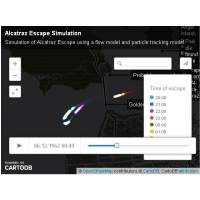Dutch Scientists Chart a Course for Mysterious 1962 Escape from Alcatraz

No one ever officially escaped from Alcatraz Federal Penitentiary during its 29-year history. Thirty-six men (two of them twice) attempted 14 escapes from the island in the San Francisco Bay.
Joe Bowers made the first break for it on April 27, 1936, when he bolted from his job burning trash at the incinerator and tried to climb a chain-link fence. A guard shot him dead.
The next-to-last attempt, on June 11, 1962, was more thoughtfully planned and the outcome considerably more hazy. Three men planted carefully-crafted dummies in their bunks, used spoons to dig through prison walls to a raft they made from raincoats, and sailed to freedom—or death.
The movie “Escape from Alcatraz,” starring Clint Eastwood, hinted (spoiler alert) that they made it, but there has been little evidence they survived the choppy waters and strong tides that very well could have swept them out to sea.
Until now.
Dutch scientists have created a computer program to mimic conditions the night Frank Morris and brothers John and Clarence Anglin slipped away. They used historical tide data, timing information from writings by a fourth prisoner who, at the last moment, didn’t leave, and factors like paddling effect to run dozens of simulations.
They couldn’t pin down the departure time exactly, so the results lacked certainty, and they used various launch points. But Fedor Baart, a hydraulic engineer who assisted with the project, told CNET:
“The simulations show that if the prisoners had left before 23.00, they would have had absolutely no chance of surviving. The strong currents would have taken them out to sea. However, if they left between 23.00 and midnight, there is a good chance they reached Horseshoe Bay north of the Golden Gate Bridge.”
The model predicted that if they landed at the bridge, their debris would have floated to Angel Island, which is where a paddle and some of their stuff was later found. If they left early—some have speculated that 10 p.m. was a likely time—the gear would not have ended up there.
The Alcatraz project was not planned. It grew out of work being done by Olivier Hoes, a researcher at Delft University of Technology (TU Delft) and a consultant with Nelen & Schuurmans. He was trying to create a model for analyzing the flood risk for large industrial facilities in San Francisco Bay at University of California, Berkeley.
A colleague, Rolf Hut, saw its possible application to the Alcatraz escape mystery and they consulted Baarth, an expert on particle tracking and a project was born.
As for that other project the scientists were originally working on, it turned out OK, too. It “simulates flooding in two dimensions using a DEM. The 3Di package applies the finite-volume staggered grid method to shallow water equations with rapidly varying flows.”
It is surely important research, but you won’t find it the subject of “Myth Busters” any time soon.
–Ken Broder
To Learn More:
Map Shows How Alcatraz Escapees Could Have Survived (by Nick Stockton, Wired)
1962 Alcatraz Escape Was Survivable, Scientists Show How (by Amanda Kooser, CNET)
Dutch Scientists Show: The 1962 Alcatraz Escape Was Possible (by Roy Meijer, Delft University of Technology)
- Top Stories
- Controversies
- Where is the Money Going?
- California and the Nation
- Appointments and Resignations
- Unusual News
- Latest News
- California Forbids U.S. Immigration Agents from Pretending to be Police
- California Lawmakers Urged to Strip “Self-Dealing” Tax Board of Its Duties
- Big Oil’s Grip on California
- Santa Cruz Police See Homeland Security Betrayal in Use of Gang Roundup as Cover for Immigration Raid
- Oil Companies Face Deadline to Stop Polluting California Groundwater





